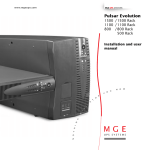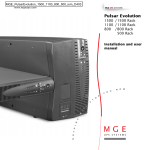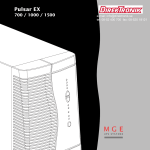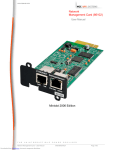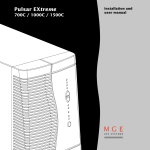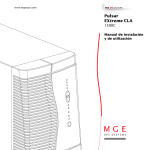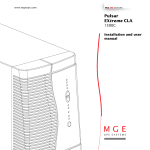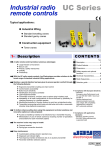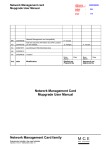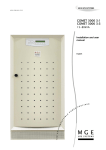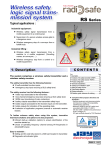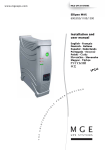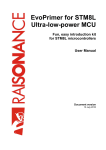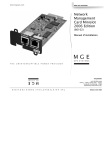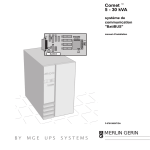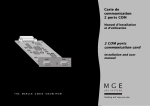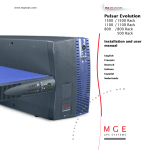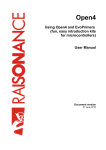Download User Manual - Electrocomponents
Transcript
Comet EXtreme 4.5/6/9/12 kVA installation and user manual 51033212EN/AA - Page 1 Introduction Thank you for selecting an MGE UPS SYSTEMS product to protect your electrical equipment. The Comet EXtreme range has been designed with the utmost care. We recommend that you take the time to read this manual to take full advantage of the many features of your UPS. MGE UPS SYSTEMS pays great attention to the environmental impact of its products. Measures that have made Comet EXtreme a reference in environmental protection include: ◗ production in an ISO 14001 certified factory; ◗ recycling of Comet EXtreme at the end of its service life. To discover the entire range of MGE UPS SYSTEMS products and the options available for the Comet EXtreme range, we invite you to visit our web site at www.mgeups.com or contact your MGE UPS SYSTEMS representative. Page 2 - 51033212EN/AA Safety Safety rules Safety of persons A UPS has its own internal power source (the battery). Consequently, the output terminals may be energized even if the UPS is disconnected from the AC-power source. Dangerous voltage levels are present within the UPS. It should be opened exclusively by qualified service personnel. The UPS must be properly earthed. The battery supplied with the UPS contains small amounts of toxic materials. To avoid accidents, the directives listed below must be observed. ◗ Never operate the UPS if the ambient temperature and relative humidity are higher than the levels specified in the documentation. ◗ Never burn the battery (risk of explosion). ◗ Do not attempt to open the battery (the electrolyte is dangerous for the eyes and skin). ◗ Comply with all applicable regulations for the disposal of the battery. Product safety The UPSs connection to the AC-power source must be protected by a circuit breaker that is easily accessible. The UPS can be disconnected from the AC-power source by opening the circuit breaker. ◗ Never install the UPS near liquids or in an excessively damp environment. ◗ Never let a liquid or foreign body penetrate inside the UPS. ◗ Never block the ventilation grates on the front or back of the UPS. ◗ Never expose the UPS to direct sunlight or a source of heat. Special precautions The UPS connection instructions contained in this manual must be followed in the indicated order. Check that the indications on the rating plate correspond to your AC-power system and to the actual electrical consumption of all the equipment to be connected to the UPS. If the UPS is positioned flat, check that not more than five modules are stacked on top of each other. If the UPS must be stored prior to installation, storage must be in a dry place. The admissible storage temperature range is -40° C to +50° C. If the UPS remains de-energized for a long period, we recommend that you energize the UPS for a period of 24 hours, at least once every month. This charges the battery, thus avoiding possible irreversible damage. 51033212EN/AA - Page 3 Foreword Using this document Information may be found primarily by consulting: ◗ the contents; ◗ the index. Pictograms Important instructions that must always be followed. Information, advice, help. Visual indication. Action. Audio indication. In the illustrations on the following pages, the symbols below are used: LED off. LED on. LED flashing. Page 4 - 51033212EN/AA Contents 1. 2. Presentation 1.1 Comet EXtreme range ................................................................................................................ 7 1.2 Back ............................................................................................................................................. 9 1.3 Control panel ............................................................................................................................... 10 Installation 2.1 Unpacking and checks ............................................................................................................... 11 "Tower" and "rack" model: 4,5 and 6 kVA ..................................................................................... 11 "Tower" and "rack" model: 9 and 12 kVA ...................................................................................... 12 3. 2.2 Installation (rack version) .......................................................................................................... 13 2.3 Battery-module connections ..................................................................................................... 14 2.4 Connection to the RS 232 communications port (optional) ................................................... 15 2.5 Installation of the communications-card option ...................................................................... 15 2.6 Connection to the connection modules ................................................................................... 16 Operation 3.1 Operating mode .......................................................................................................................... 17 ON-LINE mode ............................................................................................................................. 17 ECO mode .................................................................................................................................... 17 3.2 Start-up ........................................................................................................................................ 18 3.3 Bargraph indications .................................................................................................................. 18 3.4 Failure of AC input power and operation on battery power .................................................... 19 Transfer to battery power .............................................................................................................. 19 Threshold for the low-battery shutdown warning .......................................................................... 19 End of backup time ....................................................................................................................... 19 Sleep mode ................................................................................................................................... 19 Return of AC input power .............................................................................................................. 19 51033212EN/AA - Page 5 Contents 3.5 Personalization ........................................................................................................................... 20 Function ........................................................................................................................................ 20 "ON / OFF conditions" tab ............................................................................................................. 20 "Battery" tab .................................................................................................................................. 21 "Output" tab ................................................................................................................................... 21 "By-pass" tab ................................................................................................................................ 21 "ECO mode" tab ............................................................................................................................ 22 3.6 4. 5. 6. Page 6 - 51033212EN/AA Shutdown ..................................................................................................................................... 22 Maintenance 4.1 Troubleshooting .......................................................................................................................... 23 4.2 Replacement of the electronic module ..................................................................................... 25 Environment ..................................................................................................................................... 26 Appendices 6.1 Glossary ....................................................................................................................................... 27 6.2 Index ............................................................................................................................................. 29 1. Presentation 1.1 Comet EXtreme range 4,5 and 6 kVA tower models: Dimensions in mm (H x W x D) Electronic module 443 x 173 x 465 Battery module 443 x 173 x 465 Weight in kg Electronic module 14 Battery module 48 4,5 and 6 kVA rack models: Dimensions in mm (H x W x D) Electronic module 177 (4U) x 483 x 462 Battery module 177 (4U) x 483 x 462 Weight in kg Electronic module 18 Battery module 51 51033212EN/AA - Page 7 1. Presentation 9 and 12 kVA tower models: Dimensions in mm (H x W x D) Electronic module 443 x 216 x 465 Battery module 443 x 173 x 465 Weight in kg Electronic module 22 Battery module 48 9 and 12 kVA rack models: Dimensions in mm (H x W x D) Electronic module 221 (5U) x 483 x 462 Battery module 177 (4U) x 483 x 462 Weight in kg Page 8 - 51033212EN/AA Electronic module 27 Battery module 51 1. Presentation 1.2 Back Comet EXtreme 4,5 and 6 kVA: 1 RS232 communications port. 2 battery circuit breaker. 3 communications-card option. 4 EXB battery module connector. 5 connector for battery extension modules. 6 rating plate. 7 manual by-pass switch. 8 connection module. 9 output terminal block. 10 input terminal block. Comet EXtreme 9 and 12 kVA: 4 51033212EN/AA - Page 9 1. Presentation 1.3 Control panel Page 10 - 51033212EN/AA Alarms % battery ␣ ␣ remaining % load 11 UPS overload 100% 100% 12 electronics fault 80% 80% 13 battery fault 50% 50% 14 ambient temp. > 40°C 20% 20% 15 hold down to display percent load. 16 lamp test or buzzer OFF. 17 operation on manual bypass. 18 operation in ECO mode. 19 operation in ON-LINE mode. 20 operation on battery power. 21 ON/OFF. 2. Installation 2.1 Unpacking and checks Comet EXtreme 4,5 and 6 kVA: Electronic module 22 23 24 22 25 23 24 26 25 battery module 25 27 25 27 26 22 RS 232 communications cable. 25 documentation. 23 "Solution Pac" CD ROM. 26 telescopic rails for mounting in 19" bay with mounting hardware. 24 "UPS Driver" diskette. 27 cable for connection to battery module. 51033212EN/AA - Page 11 2. Installation Comet EXtreme 9 and 12 kVA: Electronic module 23 22 24 22 25 23 24 26 25 Battery module 25 27 27 25 26 Page 12 - 51033212EN/AA 27 27 22 RS 232 communications cable. 25 documentation. 23 "Solution Pac" CD ROM. 26 telescopic rails for mounting in 19" bay with mounting hardware. 24 "UPS Driver" diskette. 27 cable for connection to battery module. 2. Installation 2.2 Installation (rack version) Rack mounting diagram with rails. 1 3 3 3 4 3 2 The rails and the necessary mounting hardware are supplied with the UPS in the package. 51033212EN/AA - Page 13 2. Installation 2.3 Battery-module connections Comet EXtreme 4,5 and 6 kVA: Check that the battery circuit breaker 2 is OFF. Connect cable 27 to the connectors 4 of the electronic and battery modules. 2 4 27 Comet EXtreme 9 and 12 kVA : Check that the battery circuit breaker 2 is OFF. 2 4 27 Page 14 - 51033212EN/AA Connect cable 27 to the connectors 4 of the electronic and battery modules. 2. Installation 2.4 Connection to the RS 232 communications port (optional) 1 1. Connect the RS 232 communications cable 22 to the serial port on the computer. 22 2. Connect the RS 232 communications cable 22 to the RS 232 communications port 1 on the UPS. The UPS can now communicate with all MGE UPS SYSTEMS supervision, set-up or safety software. Pin-out diagram for the RS 232 communications port 1 on the UPS. RD TD OV 5 4 9 3 2 8 1 7 6 RTS 2.5 Installation of the communications-card option 3 Slots for communications card. It is not necessary to shut down the UPS to install the communications card: 1. Remove the slot cover 3 . 2. Insert the card in the slot. 3. Secure the card with the two screws. 51033212EN/AA - Page 15 2. Installation 2.6 Connection to the connection modules This type of connection must be carried out by qualified electrical personnel. Before carrying out any connections, check that the battery circuit breaker 2 is OFF and that the upstream protection devices ( AC-power source) are open (OFF). The overall cable diameter and the cross-sectional area of the three wires depends on the UPS rating. cable diameter (mm) 29 cross-sectional area of each wire (mm2) flexible rigid EXtreme 4,5 to 6 kVA 15 to 25,5 4 to 10 4 to 16 EXtreme 9 to 12 kVA 15 to 25,5 10 10 to 16 28 1. Remove the terminal-block cover 28 . 2. Remove the cable entry knockouts from the cover. 3. Loosen the cable clamp 29 . 4. Insert the cable supplying the equipment and the power cable through the terminal-block cover 28 . Always connect the earthing wire first. 9 10 28 29 10 9 Earthing wires Page 16 - 51033212EN/AA 5. Connect the three wires of the equipment cable to the output terminal block 9 . 6. Connect the three wires of the power cable to the input terminal block 10 . 7. Tighten the cable clamp 29 . 8. Refit and secure the terminal-block cover 28 . 3. Operation 3.1 Operating mode ON-LINE mode This is the standard operating mode, set by default in the factory. It makes use of electronic double conversion of the input power. Two possible cases: 19 LED 19 is ON: AC input power is available. Power is drawn from the AC-power source and supplied to the protected equipment via the UPS. LED 20 is ON: AC input power is not available. Power is drawn from the battery and supplied to the protected equipment. 20 ECO mode The main advantage of this mode is that it reduces the consumption of electrical power. The protected equipment is supplied directly by the AC-power source as long as it remains within the tolerances set by the user. ECO mode is selected and tolerance levels are set using the "UPS Driver" software 24 for UPS personalization (see section 3.5). Three possible cases: 18 The AC-power source is within the set tolerances. The protected equipment is supplied directly by the AC-power source, via the automatic bypass. LED 18 is ON. The AC-power source is not within the set tolerances. The UPS automatically shifts to ON-LINE mode. LED 19 is ON. 19 The AC-power source is not available. LED 20 is ON. The battery supplies power to the protected equipment. 20 51033212EN/AA - Page 17 3. Operation 3.2 Start-up The protected equipment connected to the UPS can be energized, whether AC input power is available or not. Prior to initial start-up, check the UPS voltage settings. If the protected equipment voltage is other than 230 V / 50 Hz, the UPS settings must be modified using the "UPS Driver" software 24 (see section 3.5). 1. Set the battery circuit breaker(s) 2 to ON. 2 2. Press the ON / OFF button 21 . All connected equipment is energized. The buzzer sounds. LEDs 18 , 19 and 20 go ON. 21 If LEDs 18 , 19 and 20 do not go ON or if LEDs 11 , 12 , 13 or 14 flash, there is a fault (see section 4.1). 3.3 Bargraph indications LEDs 11 to 14 provide three different indications. 1. Remaining backup time in percent (in ON-LINE mode). 11 12 13 14 2. Percent load drawn by the protected equipment, when button 15 is pressed. 3. Operating faults (flashing LED and beeps): 15 11 Overload. 12 UPS fault. 13 Battery fault. 14 Excessive ambient temperature. Page 18 - 51033212EN/AA 3. Operation 3.4 Failure of AC input power and operation on battery power AC input power is not available, the battery steps in to supply the protected equipment. Transfer to battery power The AC-power source is outside tolerances, LED 20 is ON, the buzzer beeps three times. 20 Threshold for the low-battery shutdown warning The low-battery shutdown warning threshold can be set by the user, with the "UPS Driver" software (see section 3.5). LED 20 flashes. The buzzer beeps every three seconds. 20 There is very little remaining battery backup time. Close all applications because UPS automatic shutdown is imminent. End of backup time The buzzer sounds continuously. Press button 16 to turn the buzzer OFF. 16 The equipment is no longer supplied with power. Sleep mode This operating mode may be personalized using the "UPS Driver" software (see section 3.5). It saves battery power when no equipment is connected to the UPS. The UPS automatically restarts when the AC-power source returns to within tolerances. Return of AC input power If, in spite of the return of AC input power, the UPS does not restart, check that the automatic-restart function (activated by return of AC input power) has not been disabled (see section 3.5). 51033212EN/AA - Page 19 3. Operation 3.5 Personalization Function Personalization parameters can be set and modified using the "UPS Driver" software installed on a computer that is connected to the UPS (see section 2.3 Connection to the RS 232 communications port). Check that the RS 232 cable 22 is correctly connected and that the battery circuit breaker 2 is closed. "UPS Driver" installation: 1. Insert the "UPS Driver" diskette in the drive of an IBM-compatible microcomputer. 2. Select the disk drive (A :\). 3. Double-click "upsdriv.exe". Once "UPS Driver" has been installed, UPS parameters can be modified in a window containing a number of tabs, each presenting a set of parameters. "ON / OFF conditions" tab Page 20 - 51033212EN/AA Personalizable function Default setting Automatic start Enabled Cold start (battery power) Enabled Forced shutdown Enabled Sleep mode Disabled UPS ON / OFF via software Enabled 3. Operation "Battery" tab Personalizable function Default setting Options "Battery test" intervals Every day Once a week Once a month No test "Low-battery shutdown warning" threshold 20% remaining battery backup time 40% remaining battery backup time Charger Standard CLA (2, 4 or 8 hours) "Output" tab Rated AC-power source voltage (see figure 1) 230 V 200 V-208 V-220 V-240 V Rated AC-power source frequency 50 Hz 60 Hz Tolerance for AC-power source frequency (fig. 2) ± 5% ± 1% to ± 10% , in 1% steps Frequency-regulation rate Standard Redundancy (see section 6.1) Alarm threshold for overload 100% 0 to 100%, in 10% steps Restart inverter after short circuit Disabled Enabled (click to add check) Authorized voltage range for transfer to bypass (see figure 3) if fault or overload 187 V to 265 V (for 230 V rated voltage) 187 V to 265 V, in 1V steps Authorized frequency range for transfer to bypass (see figure 2) if fault or overload ± 10% ± 1% to ± 10%, in 1% steps Transfer to bypass if overload Enabled Disabled (click to remove check) Transfer to bypass following a fault, whatever the conditions on the AC-power source Disabled Enabled (click to add check) "By-pass" tab The value selected for the rated UPS voltage impacts on the power available at UPS output (see the diagram below). Available power as a percentage of the rated power Authorized frequency range for transfer to bypass Tolerance for AC-power source frequency Fig. 1 Voltage in V Mini Maxi Fig. 2 51033212EN/AA - Page 21 3. Operation "ECO mode" tab ECO mode is not possible unless it has first been authorized using the "UPS Driver" software Personalizable function Default setting Options ECO mode authorization Disabled (not authorized) Enabled (click to check) Authorized voltage range for operation in ECO mode (see figure 3) Range for minimum authorized voltage for operation in ECO mode 200 V to 240 V (for 230 V rated voltage) The upper threshold (max. voltage) is between the maximum authorized voltage for transfer to the bypass and the rated voltage. The lower threshold (min. voltage) is between the minimum authorized voltage for transfer to the bypass and the rated voltage. Range for maximum authorized voltage for operation in ECO mode Voltage in V Minimum authorized voltage for transfer to the bypas Rated voltage Maximum authorized voltage for transfer to the bypass Fig. 3 3.6 Shutdown 1. Press button 21 (return to the OFF position). The connected equipment is no longer supplied with power. 21 2. Set the battery circuit breaker(s) 2 to OFF. The battery is no longer recharged. 2 Page 22 - 51033212EN/AA 4. Maintenance 4.1 Troubleshooting If any of LEDs 11 , 12 , 13 or 14 flash, there is a operating anomaly or an alarm. If a LED flashes, the bargraph data is no longer displayed. Troubleshooting not requiring MGE after-sales support Indication Signification LED 11 flashes and the buzzer UPS overload. Overload is too long beeps. or too high. The UPS cuts the supply of power to the connected equipment and the buzzer sounds continuously. The ambient temperature is higher than 40° C. LED 14 flashes. Correction Check the power drawn by the equipment and disconnect any non-priority devices. Install the UPS in a room where the ambient temperature is not greater than 40° C. The UPS is not designed to operate more than eight hours under these conditions. LED 17 is ON. The UPS is in maintenance mode (bypass) Turn the manual bypass switch to "NORMAL" position. 51033212EN/AA - Page 23 4. Maintenance Troubleshooting requiring MGE after-sales support Indication Signification LED 12 flashes and the buzzer beeps. UPS electronics have detected a UPS fault. Depending on the UPS personalization parameters (see section 3.5), there are two possibilities: ◗ the equipment connected to the UPS continues to be supplied, but directly from the AC-power source (via the automatic bypass (LED 18 ON); Correction Follow the UPS replacement procedure (see section 4.2). Call the after-sales support department. the connected equipment is no longer supplied. ◗ The equipment connected to the UPS is no longer protected. LED 13 flashes. Page 24 - 51033212EN/AA A battery fault was detected during the battery test. Make sure that the battery circuit breaker(s) is closed.If that is the case, call the after-sales support department because the battery is not OK 4. Maintenance 4.2 Replacement of the electronic module Disconnecting the connection module: 1. Turn the manual bypass switch 7 from the NORMAL to the intermediate position. 2. Check that LED 18 is ON before continuing to the BYPASS position. Before turning the switch, see the manual NORMAL BY-PASS If LED 18 is not ON, do not switch to the BYPASS position and call the after-sales support department. 18 Before turning the switch, see the manual NORMAL BY-PASS 3. Turn the manual bypass switch 7 from the intermediate position to the BYPASS position. The connected equipment is supplied by the AC-power source, via the manual bypass. 4. Shut down the UPS by pressing button 21 (return to the OFF position). 5. Switch the battery circuit breaker(s) 2 to the OFF position. 6. Remove the two fixing screws 30 to free the connection module 8 . 7. Remove the connection cable(s) from the battery module(s). The UPS can be replaced. The connected equipment is supplied by the AC-power source. Reconnecting the connection module: 1. Secure the connection module 8 using the two screws 30 . 3. Reconnect the connection cable(s) to the battery module(s). 3. Switch the battery circuit breaker(s) 2 to the ON position. 21 2 Check that UPS personalization settings still correspond to the equipment to be supplied (see section 3.5). 4. Start the UPS by pressing button 21 . 5. Check that LED 18 is ON before turning the manual bypass switch 7 to the intermediate position. If LED 18 is not ON, do not switch to the intermediate position and call the after-sales support department. 30 8 6. Turn the manual bypass switch 7 from the BYPASS position to the intermediate position and check that LED 18 is ON. 7. Turn the manual bypass switch 7 from the intermediate position to the NORMAL position. The connected equipment is again protected by the UPS. 51033212EN/AA - Page 25 5. Environment This product has been designed to respect the environment: It does not contain CFCs or HCFCs. It was manufactured in a factory certified ISO 14001. UPS recycling at the end of service life: MGE UPS SYSTEMS undertakes to recycle, by certified companies and in compliance with all applicable regulations, all UPS products recovered at the end of their service life (contact your branch office). Packing: UPS packing materials must be recycled in compliance with all applicable regulations. Warning: This product contains lead-acid batteries. Lead is a dangerous substance for the environment if it is not correctly recycled by specialized companies. Web site : www.mgeups.com Page 26 - 51033212EN/AA 6. Appendices 6.1 Glossary Authorized voltage range for operation in ECO mode The range of voltage supplied by the AC-power source within which the UPS can operate in ECO mode. In this mode, the equipment connected to the UPS is supplied directly by the AC-power source, via the automatic bypass. Authorized voltage range for transfer to bypass if fault or overload Upper and lower voltage thresholds within which the UPS can operate on the automatic bypass in the event of a UPS fault or overload. Automatic bypass Automatic switch controlled by the UPS, used to connect the equipment directly to the AC-power source. Automatic start following return of AC input power When AC input power returns following shutdown at the end of the battery backup time, UPS automatic start can be enabled or disabled. Backup time Time that the connected equipment can operate on battery power. Bargraph Device on the front panel indicating the percent remaining backup time or the percent load. Battery test Internal UPS test on battery status. Cold start See "Start on battery power". Connection module Unit grouping the receptacles for connection to the AC-power source and the equipment. Dialog box A window in a computer program displayed for selection by the user of various options and parameter settings. Double conversion The power supplied to the connected equipment is completely regenerated by continuous double conversion, i.e. the AC power from the AC-power source is rectified (AC - DC), then converted back (DC - AC) to AC power. ECO mode Operating mode by which the equipment is supplied directly by the AC-power source if it is within the tolerances defined by the user. This mode reduces the consumption of electrical power. Equipment Devices or systems connected to the UPS output. Forced shutdown Ten-second interruption in the supply of power to the connected equipment following a system shutdown, even if AC input power returns during the interruption period. 51033212EN/AA - Page 27 6. Appendices Frequency-regulation rate The rate at which the UPS frequency is synchronized with that of the AC-power source. Two possible cases: 1. The installation comprises a single UPS. The frequency-regulation rate is set to "Standard". 2. The installation comprises two UPSs connected in series. The AC-power source supplies power to the first UPS which in turn supplies the second UPS. The connected equipment is supplied by the second UPS. The frequency regulation rate of the first UPS must be set to "Standard", the frequency regulation rate of the second UPS must be set to "Redundancy". Manual bypass Rotary switch controlled by the user, used to connect the equipment directly to the AC-power source. Transfer of the load to the manual bypass enables UPS maintenance or replacement, without interrupting the supply of power to the connected equipment. ON-LINE mode The normal UPS operating mode, by which the AC-power source supplies the UPS, which in turn, following double conversion of the AC power, supplies the connected equipment. Percent load Ratio between the power drawn by the connected equipment and the total power that the UPS can supply. Personalization A number of UPS functions can be modified using the "UPS Driver" software to better meet the user's needs. Redundancy See "Frequency-regulation rate". Sleep mode This function shuts down the UPS when it operates on battery power and no load is detected on the UPS output. Start on battery power This function makes it possible to energize the connected equipment even when AC input power is not available (operation exclusively on battery power). Tolerance for AC-power source frequency The range of frequency supplied by the AC-power source within which the UPS can operate in ON-LINE mode (double conversion). UPS Uninterruptible Power Supply. UPS ON / OFF via software It is possible to enable or disable use of UPS ON / OFF controls by the computer-system protection software. Page 28 - 51033212EN/AA 6. Annexes 6.2 Index A M AC power Failure ........................................................... 19 Frequency tolerance ..................................... 21 Rated frequency ............................................ 21 Rated voltage ................................................ 21 Return ............................................................ 19 Mode ECO mode .......................................... 10-17-22 ON-LINE mode ......................................... 10-17 B P Bargraph .............................................................. 18 Battery Battery test .................................................... 21 End of backup time ....................................... 19 Fault ......................................................... 10-18 Low-battery shutdown warning ..................... 19 Recycling ....................................................... 26 Transfer to battery power .............................. 19 Buzzer .................................................... 4-10-18-19 By-pass Automatic bypass ..................................... 17-24 Manual bypass ........................................... 9-25 Personalization .............................................. 20-22 Battery .......................................................... 21 ECO mode .................................................... 22 ON / OFF conditions ..................................... 20 Output ........................................................... 21 C Communication .................................................... 15 Connection Communications card ................................... 15 Connection modules ..................................... 16 RS 232 communications port ........................ 15 E O Overload .................................................... 10-21-23 R Rack .................................................... 7-8-11-12-13 S Safety .................................................................... 3 Shutdown Forced shutdown ........................................... 20 UPS ON / OFF via software .......................... 20 UPS shutdown ......................................... 10-22 Sleep mode ................................................... 19-20 Software UPS Driver ............................... 11-12-18-20-22 Start-up Automatic start .............................................. 20 ECO mode ................................................ 10-17-22 T F Temperature Excessive ambient temp .................... 10-18-23 Fault (UPS) Load .............................................................. 10 Transfer to automatic bypass ........................ 24 L U UPS Driver ...................................... 11-12-18-20-22 LEDs Lamp test ....................................................... 10 51033212EN/AA - Page 29 140, Avenue Jean Kuntzmann ZIRST - Montbonnot St Martin 38334 - ST ISMIER CEDEX - FRANCE www.mgeups.com 51033212EN/AA Page 30 - 51033212EN/AA Nothing will stop you now Publication : MGE UPS SYSTEMS, 01/2000. MGE UPS SYSTEMS































